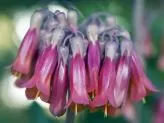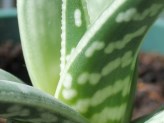The other Carrion Flower
Many species of Huernia have been moved to this genus from their closely related cousins, the Stapelia.

Over the several centuries since their discovery by missionaries in South Africa, these interesting plants have been grown as odd houseplants or in conservatories and greenhouses, but originally the villagers in South Africa used them as a food plant, boiled like a vegetable.
Huernia resemble Stapelia by producing the distinctly scented flowers that lead to the name of Carrion Flower.
The smell and the dark red of some types resemble the blood or flesh of dead animals, which attracts the flies that pollinate them.
The green stems have adapted to perform the same function as leaves, with less likelihood of damage from excessive heat and drought.
The green colour indicates that they can photosynthesize, making sugar from the presence of light.
They can exist in extremely difficult situations; if a long dry period persists, the stems simply shrivel gradually until the next rainfall.
The sharp looking ‘thorns’ are all show – they are soft, and can’t harm your skin.
In time, they’ll bloom, usually after a drought ends, and they can again receive water.
Let this little characteristic allow you to promote blooming when you want it, not when the plant decides it’s time.
Honestly, the smell of some of the different species is pretty overwhelming, and you will be happier if they perform this duty out in the fresh air.
For summer, Huernia and Stapelia both do best in some type of lath house, or at least dappled shade.

Even though they originate in extremely hot areas of the world, the fact that they aren’t frost hardy makes it difficult to provide enough light in the winter time to keep them toughened up from too much light.
I find for the winter, 12 hours under fluorescent grow lights is perfect, as they come from around the equator. This will give them a similar photoperiod to their native lands.
As succulents, they require well drained soil, and do quite well without much in the way of fertilizer.
To promote bloom without too much excessive growth you can fertilize with a weak solution of 5-10-10 fertilizer (the first number is Nitrogen, so any fertilizer with lower numbers there will be best for succulents).
For an organic choice, simply sprinkle some worm castings on the top of the soil, which act as a slow release fertilizer whenever you water.
See more about this fascinating plant below…
…and find out what other visitors have said about Huernia…
Flowering Cactus from a yard sale.
Long spiky limbs, small pink flowers This plant is one of my favorites; it’s called Huernia, and is also known as the Carrion Plant because of the …
Unknown Huernia,very pretty!
Hi,someone gave me a lovely huernia(I think it’s one!) but I can’t find a photo of it anywhere. The stems look like a Huernia, and the flowers are …
please help identify
I recieved small pieces of this plant, from a friend, a few weeks ago. She was unsure what it was. It is obviously a fast grower. I thought it was a …
Long tail-like spiky succulent – No spines
This curiously odd, slow-growing plant features long spiky “tails” with no thorns/spines. Each tubular leaf has 6 rows of soft spikes running along its …
Like pale green slugs with fleshy scales
Pale green stems with rows of fleshy scales. The scales are usually in rows along the stems but not always. Stems spawn new stems in a seemingly random …











